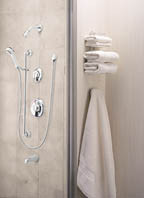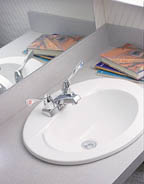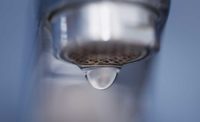
Issue: 6/02
The more technological bells and whistles, the more the potential for problems at every turn, right? Not always so, as demonstrated by many recent innovations in faucets and plumbing fixtures. Specifically designed to make everyday usage easier and more intuitive, these technological advances often simplify installation and maintenance as well.
Installation
Installation is the first order of business with any new faucet. Whether in a residential or commercial setting, the complexity of the installation and the associated costs are the factors an architect, designer or engineer must consider when specifying faucets. Tradesmen such as plumbers and electricians often prefer to approach an installation without reference to instructions. Therefore, the more obvious the installation procedure, the easier and less costly the project. Fewer, even pre-assembled components and a minimum number of required, readily available tools also help to facilitate the job.
Some faucet manufacturers even offer modular installation technology, enabling one-time installation of valving with future style changes simply done above the sink deck or outside the shower wall. Supplementing any of these installation features with easy-to-follow and understandable instructions is a key element for both tradesmen as well as do-it-yourselfers. Look for installation assistance that includes printed instruction sheets; visual and interactive media such as CDs or Web site videos; and well-trained, accessible customer service representatives.
Maintenance
Once installed, quality and durability become essential elements for the long-term maintenance of the faucet. Avoiding callbacks to the plumber to repair or replace a defective or malfunctioning faucet, particularly within the warranty period, is a primary consideration for faucet specification. To minimize the frequency of such callbacks, major faucet manufacturers work to ensure high-quality components and faucet construction, vandal-resistant features for commercial products, and robust, easy care finishes. And, if a callback does become necessary, the plumber would prefer faucet specifications for manufacturers who offer replacement parts, a minimum of required tools, comparatively easy access to the faucet, and easily accessible customer support.
Everyday Use
No matter where a faucet or plumbing fixture is installed, ease of daily use is the element that ultimately defines the success of the product. For homeowners, the major expectations for a faucet are attractive styling; easy care and cleaning; and safe, effortless delivery of water for everyone in the household, including children and aging family members. The expectations for easy, everyday use are essentially the same in commercial settings, ranging from lighter environments, such as hospitality settings, educational facilities, and assisted living accommodations, to heavier applications such as sports and entertainment complexes, hospitals and healthcare facilities, and even correctional settings. In all these settings, durability is key, as faucets are subject to more frequent, rough, or even abusive use, as well as harsh cleaning environments.
Simply styled, easy-to-clean faucets that provide water to any user intuitively, safely and consistently remain the major considerations. Given these similar goals and expectations, it is not surprising that crossover is increasing between residential and commercial settings in terms of faucet styling and function, as well as technological features and benefits.
Technology in Faucets
Hands-Free Faucets Recently, the most obvious crossover product between residential and commercial applications is the electronic or "hands-free" faucet. Common in commercial settings for some time, electronic faucets and flush valves allow for hands-free activation through the use of proximity sensors, often using infrared technology, that detect the user's presence and activate water flow automatically. Particularly in public facilities with many different users, this hands-free function is appealing not only for health and sanitary reasons but also for the simplicity of activation by virtually anyone, regardless of age or physical ability. The simplicity and cleanliness of this hands free feature has fueled the crossover into residential applications, because this "no touch" activation means fewer germs, less cleaning, and simple water delivery. Most electronic faucets offer compelling water conservation features as well, with adjustable angles and distances for detection sensors as well as adjustable water flow timing and automatic shutoff. Safety from scalding can also be incorporated into electronic faucets through water temperature control devices.
Even with these powerful water conservation, safety, and sanitation features, homeowners typically desire more attractive styling than that provided by conventionally austere, commercial electronic faucets. As a result, designs for electronic faucets have improved, offering more contoured shape and elegance, for both residential and commercial environments.
From an installation and maintenance standpoint, some electronic faucets offer straightforward, battery-powered connections and functions as opposed to AC hookup "hardwiring," best provided by a licensed electrician. Going one step further toward simplification, some electronic faucets even provide low battery indicators, convertibility from common AA battery operation to hardwiring, and self-diagnostics to guide the plumbing contractor or electrician through resolution of any possible service issue. Electronic faucets are a powerful example of technology enabling easy installation and maintenance, as well as simple water activation, safety and health for the end user.
Metering Faucets
Though not always loaded with such comprehensive features as electronic faucets, other faucet innovations also address simplification of water delivery with technological solutions. Forerunners to electronic faucets in providing water conservation, metering faucets are even more prevalent in commercial markets. Through adjustable timing mechanisms, one simple touch or turn of the faucet handle activates a timed or metered amount of water for the end user, offering water conservation and ease of use benefits. Because metering faucets use mechanical rather than electronic devices, cost for the faucet, installation, and maintenance are typically lower than electronic faucets. Though metering faucets provide cost-effective specifications for water conservation in commercial markets, these features alone are not as compelling in most residential settings.
Filtering Faucets
An emerging faucet segment based on water quality and health issues is the category of filtering faucets. Building on the consumer taste and preference for bottled and filtered water, many kitchen and bathroom faucets now offer pushbutton water filtration technology right from the faucet. This integration of water filtration within a standard faucet eliminates the need in most cases for add-on sink, faucet, or whole house or facility filtration devices. In many water-filtering faucets, filter changes are an easy, slide-in procedure required every three to six months, depending upon level and frequency of use. In those settings where an existing faucet is preferred but filtered water is desired, an above-the-deck filter spout system is available for either the kitchen or the bath. For end user convenience, visual filter life indicators may even be incorporated into these water dispensers. Such technology enables the availability of better tasting, cleaner water wherever a faucet can be installed.Temperature Control
Water safety and control, particularly in applications for the bath, are addressed in a host of faucet and fixture innovations. Pressure-balancing shower systems are one example, maintaining a constant water temperature no matter what other water sources are in use. For example, with a pressure-balancing system, flushing a cold-water source toilet does not result in a flood of hot, scalding water for the person taking a shower. Instead, the temperature in the shower remains the same, without any adjustment from the user, preventing burns or discomfort from overly hot water.
Taking technology even further, some faucet manufacturers offer thermostatic systems that not only maintain constant water temperature, but also return to the user's previously defined water temperature and volume preferences with the simple adjustment of a dial. This type of personal, effortless control over water temperature and volume is more affordable and simpler today because of innovations in faucet architecture and water delivery.
